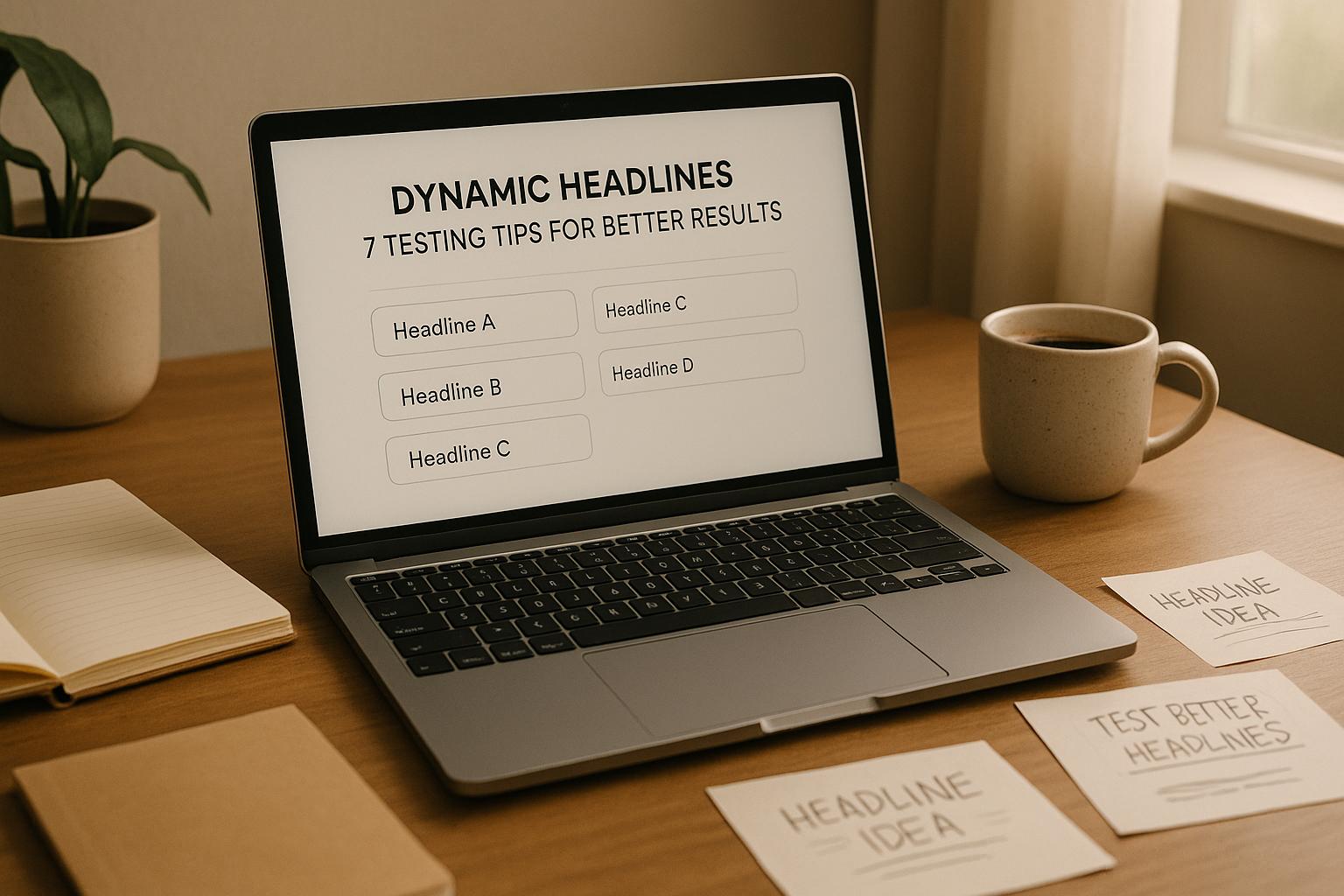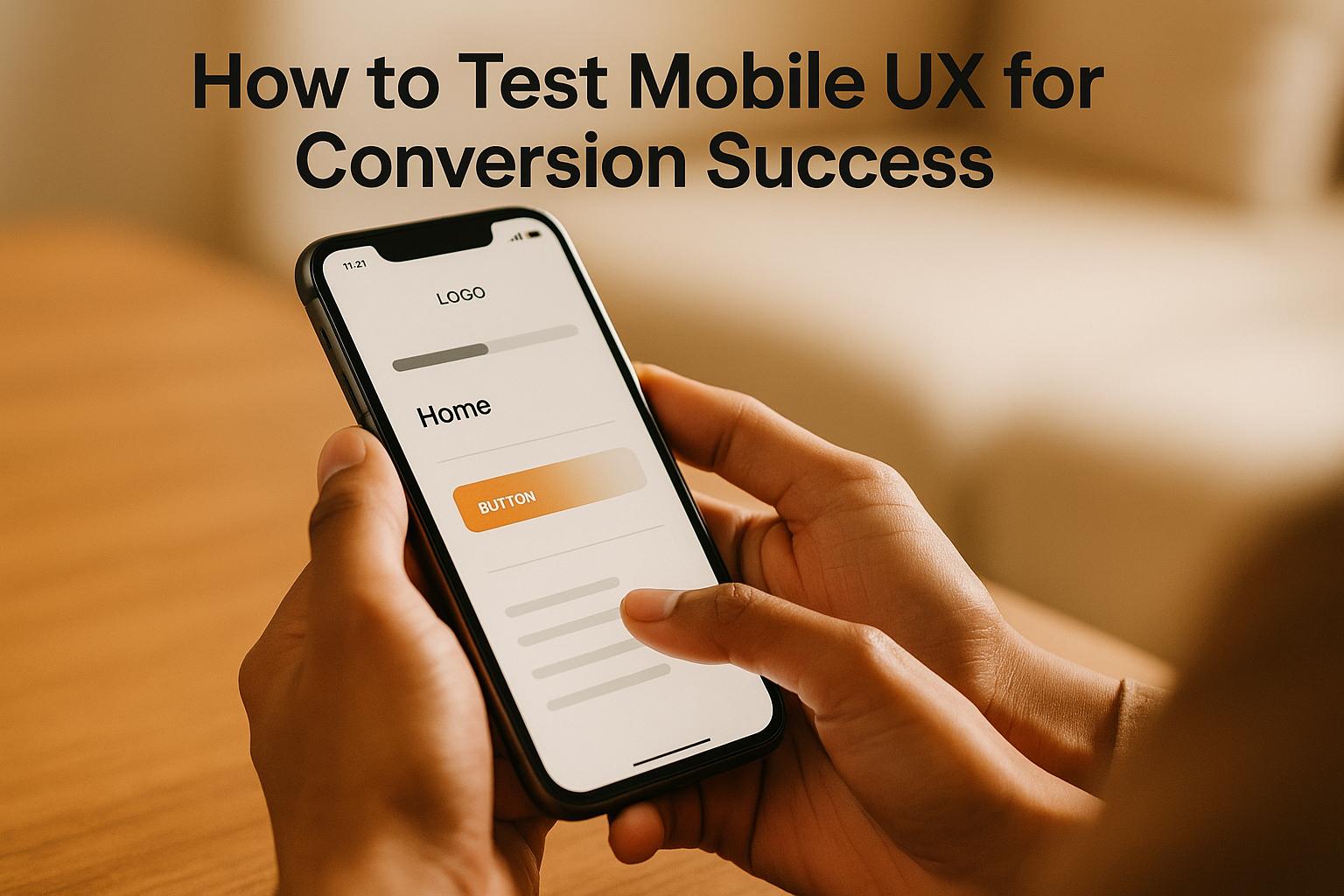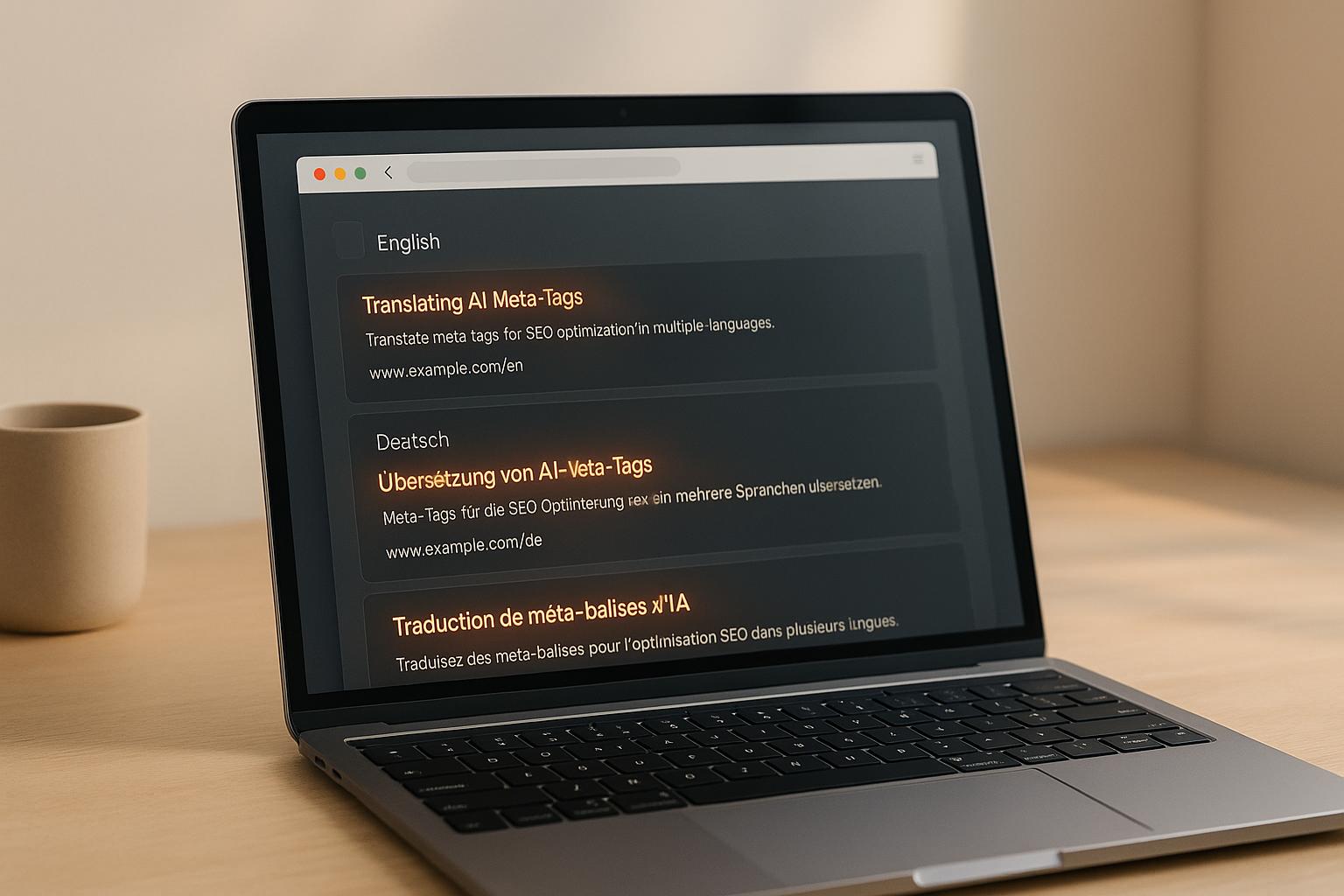

Dynamic Headlines: 7 Testing Tips for Better Results

Dynamic Headlines: 7 Testing Tips for Better Results
 18-08-2025 (Last modified: 03-09-2025)
18-08-2025 (Last modified: 03-09-2025)
Dynamic headlines adjust text based on user data like behavior or demographics, creating a personalized experience that can boost engagement and conversions. Testing these headlines is critical to understanding what works for different audiences. Here’s how to get started:
- Set Clear Goals: Define measurable objectives, like increasing click-through rates (CTR) or reducing bounce rates.
- Use AI Tools: Platforms like PageTest.AI quickly generate headline variations and analyze performance.
- Test in Real-Time: Multi-Armed Bandit (MAB) algorithms dynamically allocate traffic to better-performing headlines during tests.
- Monitor Metrics: Track impressions, clicks, and CTR while adjusting based on performance.
- Focus on Statistical Significance: Avoid premature decisions by gathering enough data for reliable results.
- Analyze User Behavior: Segment by device, traffic source, and audience to uncover patterns.
- Iterate Continuously: Regularly refine headlines based on insights and evolving trends.
Quick Comparison:
| Testing Method | Best For | Traffic Requirements | Time to Results | Key Benefit |
|---|---|---|---|---|
| A/B Testing | Simple comparisons | Low to Medium | 1–4 weeks | Reliable for small-scale changes |
| Multivariate Testing | Testing multiple elements | High | 4–8 weeks | Insights into element interactions |
| AI Bandit Testing | Continuous optimization | Medium to High | Immediate | Real-time adjustments during testing |
Start with a high-traffic page or campaign and test variations tailored to your goals. Tools like PageTest.AI simplify the process, helping you refine headlines and drive better results.
The DEFINITIVE GUIDE to DYNAMIC CREATIVE – From the Disrupter School
Set Clear Testing Goals
Before diving into headline testing, it’s crucial to establish clear goals. Without them, the data you collect might feel like noise instead of offering actionable insights. By setting specific and measurable objectives, you transform testing into a purposeful, results-oriented process. These goals serve as the backbone of effective, data-driven headline experiments.
Define Measurable Objectives
Start by identifying baseline metrics – such as click-through rate (CTR), time on page, and bounce rate – and then set clear targets for improvement. Tailor these objectives to align with the behaviors of different user groups and the factors driving their conversions.
For instance, if your current CTR is 3%, you might aim to increase it to 4% within a set timeframe. You can also create audience-specific goals, like boosting engagement among mobile users or resonating better with first-time visitors. These tailored objectives help uncover which types of messaging resonate most effectively with specific segments.
How Clear Goals Shape Test Design
Once you’ve defined your objectives, they’ll guide every aspect of your headline testing process. Clear goals influence how you design tests, create variations, set timelines, and determine success criteria.
For example, if your goal is to increase CTR, you might focus on crafting action-oriented headlines. On the other hand, if you’re aiming to boost conversions, you might test headlines that address customer pain points. The timeline for your test will depend on the scope of your goal – smaller, incremental improvements generally require less time to measure than ambitious leaps.
Tools like PageTest.AI simplify this process by aligning your headline variations with your specific goals. Whether your focus is on conversions, engagement, or targeting a particular audience, the platform automatically generates headline variants tailored to your objectives. This ensures your testing stays on track and delivers meaningful, measurable insights rather than random data points.
Use AI to Generate Headline Variations
When you have clear testing goals, using AI can make creating headline variations much easier. Crafting headlines manually can be a slow process, often resulting in limited options. AI-powered tools, on the other hand, can quickly generate a wide range of ideas, exploring different tones and angles to ensure you have diverse options for testing.
Speed and Efficiency with AI
Coming up with headline ideas manually can take hours, but AI tools can produce dozens of options in just minutes. This means you can start tests faster and update them more frequently.
Take PageTest.AI, for instance. This no-code platform automates the process of generating headline variations. Once you define your testing goals, the AI creates multiple options that test different emotions, value propositions, and calls-to-action. Instead of spending time crafting headlines yourself, you can focus on reviewing performance data and making strategic decisions. This quick turnaround lays the groundwork for refining your headlines with AI insights, which we’ll dive into next.
Improve Variations with AI Insights
AI doesn’t just help you generate headlines quickly – it also improves them. By analyzing past test results, AI tools can identify patterns in successful headlines. For example, PageTest.AI uses this data to create new variations that explore different messaging techniques, helping you figure out what connects best with your audience.
Let’s say your original headline highlights a product’s features. The AI might suggest variations that shift the focus to customer outcomes or address specific pain points. Whether it’s emphasizing urgency, showcasing benefits, or sparking curiosity with a question, the AI tailors each headline to achieve a specific goal. This approach ensures your tests cover a wide range of strategies, giving you a better shot at increasing engagement and conversions.
Run and Monitor Real-Time Testing
With your AI-generated headline variations prepared, it’s time to dive into real-time testing. This phase offers immediate insights into performance by dynamically adapting headlines based on user behavior. Unlike traditional testing methods that split traffic evenly for the entire duration, real-time testing learns and adjusts as it progresses. This means you can optimize your results while the test is still running, rather than waiting until the end to see what worked.
Real-Time Testing Techniques
One of the most effective ways to test dynamic headlines in real time is by using Multi-Armed Bandit (MAB) algorithms. These algorithms start by allocating an equal share of traffic to all headline variations but quickly adapt as they gather data, sending more traffic to the better-performing options.
For example, PageTest.AI uses Thompson sampling, a specific type of MAB algorithm. This method strikes a balance between exploitation – focusing on headlines that are already performing well – and exploration – continuing to test other variations to uncover hidden winners. This ensures ongoing optimization throughout the testing process.
Here’s how it works: If you launch a test with four headline variations, each starts with 25% of the traffic. Within a few hours, if one headline significantly outperforms the others, the algorithm might adjust the allocation, giving 40% of the traffic to the top-performing headline while reducing the others to 20% each. This dynamic approach boosts performance in real time.
The difference between MAB algorithms and traditional A/B testing is clear when you compare how they allocate traffic:
| Aspect | A/B Testing | Multi-Armed Bandit (MAB) |
|---|---|---|
| Traffic allocation | Fixed (e.g., 50/50) | Dynamic based on performance |
| Optimization timing | After the test ends | Continually during the test |
| Handling poor variants | Shows all variants equally | Reduces traffic to underperformers |
| Best Use Case | Long-term changes needing statistical significance | Quick optimization for time-sensitive content |
This makes MAB algorithms especially useful for dynamic headlines on content like breaking news, promotional campaigns, or trending topics where speed is critical.
Track and Adjust Based on Metrics
To get the most out of your testing, you need to monitor the right metrics and adjust based on the data. The key metrics to watch during headline testing are impressions, clicks, and click-through rate (CTR). These metrics provide real-time feedback on how well each headline is engaging users, creating a feedback loop that refines headline performance as user behavior changes.
PageTest.AI leverages Bayesian statistics to continuously optimize testing and offers confidence grades – High, Fair, Low, or Insufficient – to guide your decisions even before statistical significance is reached. For instance, a “High” confidence grade (indicating a 95% or higher chance of success) signals that it’s safe to implement a particular headline.
If no headline emerges as a clear winner, you can rely on the “Help Chance” metric, which estimates the likelihood of a variation outperforming the control. For example, if Headline B has a 70% help chance compared to the control, it’s a strong candidate for use, even without a definitive winner.
Adjustments are key as you gather data. If a headline consistently underperforms, the algorithm automatically reduces its traffic allocation. On the flip side, high-performing headlines receive more traffic to confirm their effectiveness.
“A machine learning method called multi-armed bandit testing, exemplified by Thompson sampling, dynamically allocates traffic to better-performing headlines”.
When monitoring tests, focus on trends over time rather than isolated results. A headline might perform well initially due to novelty but lose its impact as more users encounter it. By tracking these patterns, you can make informed adjustments to keep your tests aligned with user behavior.
If results remain inconclusive, consider narrowing the test to the top-performing variations or extending the duration to collect more data. Sometimes, eliminating the weakest options and focusing traffic on the top two or three variations is the most effective strategy.
Focus on Statistically Significant Results
Real-time testing can provide useful insights as you experiment with headlines, but the backbone of effective headline optimization is statistical significance. This means gathering enough data to ensure your results aren’t just random noise. Without it, decisions could be based on fleeting trends rather than reliable patterns.
Statistical significance often requires a 95% confidence level, meaning there’s only a 5% chance the results happened by accident. For headline testing, this often means hundreds – if not thousands – of interactions, depending on your traffic and the size of the effect you’re measuring. For instance, a headline that seems to perform 20% better after just 50 clicks might not hold up as more data rolls in.
Dynamic headlines, especially for time-sensitive content like news or promotions, often push for quick decisions. However, rushing to conclusions without adequate data can backfire in the long run. Just like real-time adjustments, ensuring statistically significant results is critical for sustained success.
Avoid Premature Decisions
While real-time tests can tempt you with immediate feedback, drawing conclusions too early can lead to misleading results. Checking results before reaching statistical significance might give a false sense of confidence. Early leaders in a test often shift as more data accumulates.
If your initial results look promising but haven’t reached significance, extend the test. Most tests need at least 24–48 hours to account for daily traffic patterns. High-traffic sites might achieve significance faster, but for low-traffic sites, patience is key.
To avoid unnecessary delays, use sample size calculators to estimate how long your test should run. These tools factor in your baseline conversion rate, the minimum improvement you’re looking for, and your daily visitor count. This ensures you’re not drawing conclusions from a test that doesn’t have enough data to be reliable.
Even if one headline is ahead early on, don’t stop the test prematurely. A headline that appears to be winning after 200 interactions might lose its edge after 2,000, as more diverse users engage with the content.
Handle Inconclusive Results
Even with careful data collection, some tests may not produce a clear winner – and that’s okay. Inconclusive results simply mean the variations performed too similarly to declare one better than the other. Instead of viewing this as a setback, consider it an opportunity to refine your approach and better understand your audience.
When faced with inconclusive results, try extending the test to gather more data. Sometimes, an additional week of testing can push results past the significance threshold. For sites with less traffic, longer tests may be unavoidable.
Another option is to narrow your focus. If you started with five headline variations and three are clearly underperforming, eliminate those and focus on the top two. This streamlined approach can help you reach meaningful results faster.
Segmentation analysis can also provide valuable insights. Your headlines might perform differently depending on factors like device type, traffic source, or user demographics. For example, a headline that doesn’t stand out overall might perform particularly well among mobile users or visitors from social media.
If results remain inconclusive even after extended testing, think about what that means for your strategy. Two headlines performing almost identically can give you flexibility. You might choose one based on other factors, like how well it aligns with your brand tone, SEO goals, or ease of localization.
Tools like PageTest.AI can help you interpret these outcomes, offering guidance on whether to make small adjustments or wait for more definitive data. Even when statistical significance isn’t fully achieved, these tools can provide clarity and direction for your next steps.
sbb-itb-6e49fcd
Analyze User Behavior for Headline Insights
Once you’ve identified the winning headline through statistical testing, the real work begins: digging into user behavior analysis. While the raw data tells you which headline performed best, understanding why it worked and how to replicate that success requires a closer look at how users interact with your content.
Beyond surface-level metrics like click-through rates, user behavior data reveals how different audience segments respond to your headlines. This deeper understanding is key to refining your approach, especially when testing dynamic headlines across various contexts.
Segment by Audience and Device
Not all users engage with content in the same way, and their behavior often varies based on factors like device type and traffic source. By analyzing your test results through segmentation, you can uncover patterns that might otherwise go unnoticed.
For example, device type often plays a significant role in headline performance. Mobile users tend to skim content quickly, favoring shorter, punchier headlines, while desktop users often prefer longer, more detailed headlines that provide additional context. A headline that seems to underperform overall might actually excel among mobile users if desktop traffic dominated the results.
Traffic source segmentation is another valuable lens. Social media visitors often respond better to emotionally charged headlines or those with curiosity-driven hooks, while users from search engines typically prefer headlines that align closely with their search intent. Similarly, direct traffic may engage with headlines that reflect familiarity or brand recognition.
Geographic and demographic segmentation can help pinpoint regional preferences or differences in audience behavior. Time-based segmentation, meanwhile, reveals whether certain headlines perform better at specific times, whether that’s particular hours of the day, days of the week, or even seasonal trends. For headlines tied to current events or promotions, timing insights can be especially impactful.
Tools like PageTest.AI make this process easier by automatically tracking device types, traffic sources, and user behavior. These insights allow you to identify which headlines resonate most with specific segments of your audience, helping you fine-tune your strategy.
Find Patterns in Interaction Data
Once you’ve segmented your audience, the next step is to analyze interaction patterns. This goes beyond basic metrics like conversions to explore how users engage with your headlines and the content that follows. Tools like heat maps, scroll depth analysis, and time-on-page metrics provide a clearer picture of how well a headline delivers on its promise.
For instance, a headline with high click-through rates but low engagement could be misleading, drawing users in but failing to meet their expectations. On the other hand, a headline with moderate click-through rates might lead to deeper engagement, with users spending more time on your site and converting at higher rates. In many cases, this kind of meaningful engagement is more valuable than sheer click volume.
Bounce rate analysis can also reveal important insights. A headline that generates a lot of clicks but a high bounce rate might be attracting the wrong audience – people who aren’t genuinely interested in your content. In contrast, a headline with fewer clicks but a lower bounce rate may be better at attracting users who align with your goals.
User flow analysis offers a broader view of how different headlines impact the entire user journey. Some headlines might drive immediate conversions, while others encourage users to explore your site or return for repeat visits. Understanding these patterns allows you to align your headline strategy with specific business objectives.
Many A/B testing platforms now offer engagement scoring, which combines multiple interaction metrics into a single measure of headline effectiveness. This holistic approach helps you identify headlines that not only attract clicks but also create meaningful user experiences.
By analyzing these patterns, you can create templates for future headlines. For instance, if emotional triggers consistently drive higher engagement among mobile users, you can apply that insight to new content. Similarly, if certain headline structures work better for specific traffic sources, you can tailor your approach accordingly.
These insights are especially valuable for refining dynamic headline strategies. Instead of rotating headlines randomly, you can use audience and device data to automatically serve the most effective variation to each segment. This ensures that every user sees the headline most likely to resonate with them, maximizing both engagement and impact.
Optimize Continuously Through Iteration
In the fast-moving digital world, staying ahead means constantly refining and improving. User preferences, seasonal trends, and market conditions shift regularly, making it crucial to revisit and optimize your strategies. What worked yesterday might not hit the mark today, which is why continuous optimization is key to maintaining long-term success.
Take headlines, for example. The best marketers know that testing and refining headlines isn’t a one-time task. Each test offers insights – not just about what works now, but about how to improve future campaigns. This ongoing process turns testing into a proactive, growth-focused strategy.
The Cycle of Testing and Refining
Optimizing headlines effectively follows a repeatable process: test, analyze, refine, and repeat. Each step builds on the last, creating a feedback loop that deepens your understanding of what connects with your audience.
When you’ve gathered enough data, analysis reveals more than just which headline performed best – it uncovers why it worked. For instance, did the winning headline succeed because it used emotional language? If so, what other emotions might resonate even more? Or maybe it included numbers – would tweaking those numbers improve engagement? Every insight sparks new ideas for testing, keeping the cycle alive.
Timing is another critical factor. User behavior isn’t static; it evolves with seasons, current events, and market trends. A headline that thrives during the holiday season might fall flat in a back-to-school campaign. Regular testing helps you anticipate these shifts, so you’re ready to adapt before performance dips.
To make the most of this approach, document your tests and schedule periodic reviews. This habit not only prevents repeating past mistakes but also helps you identify long-term patterns and trends for sustained improvement.
Use AI Tools for Iteration
Managing headline testing manually can feel overwhelming, especially when juggling multiple campaigns. That’s where AI-powered tools step in to simplify the process, automating repetitive tasks and uncovering insights that might otherwise go unnoticed.
Take PageTest.AI, for example. This platform uses artificial intelligence to generate headline options tailored to your content and goals, often pushing beyond what human creativity might suggest. It also monitors performance in real time, giving you instant feedback. Instead of waiting for scheduled reports or manually checking results, you can adjust strategies on the fly based on live data.
AI tools also excel at spotting subtle performance trends. For instance, they might reveal that shorter headlines perform better on mobile devices or that certain phrase structures resonate with specific traffic sources. These insights guide your next steps, ensuring that each test builds on the last.
Even the refinement phase benefits from AI. Based on your past results and current performance, AI can suggest new headline variations that incorporate successful elements while exploring fresh ideas. This targeted guidance keeps your testing cycles focused and productive, avoiding the randomness of trial-and-error approaches.
Integration is another advantage. Platforms like PageTest.AI connect seamlessly with popular website builders and content management systems, making it easy to implement and test new headlines without technical headaches. This streamlined process removes barriers that could otherwise slow down your optimization efforts.
While AI handles the heavy lifting – like generating variations and analyzing data – human oversight remains essential. You bring the strategic vision, interpreting results and steering the overall direction. Together, this blend of human insight and AI efficiency creates a powerful engine for continuous improvement.
It’s worth noting that AI tools get better as they learn. At first, their recommendations might feel generic, but as they analyze more of your data, their suggestions become sharper and more aligned with your audience and brand voice. Over time, this learning curve makes each iteration more impactful than the last, turning your optimization process into a compounding asset.
Compare Testing Methods for Dynamic Headlines
When it comes to optimizing dynamic headlines, selecting the right testing method can make or break your results. Each approach – A/B testing, multivariate testing, and AI-driven bandit testing – offers unique benefits and is suited to specific traffic levels and goals. Here’s a breakdown of these methods to help you decide which one aligns best with your needs.
Testing Methods Comparison
| Testing Method | Best For | Traffic Requirements | Time to Results | Pros | Cons |
|---|---|---|---|---|---|
| A/B Testing | Simple headline comparisons and clear winner identification | Low to medium (1,000+ visitors/week) | 1–4 weeks | Easy setup, clear and reliable results | Limited to 2–3 variations; slower for complex tests |
| Multivariate Testing | Testing multiple headline elements simultaneously | High (10,000+ visitors/week) | 4–8 weeks | Offers insights into how elements interact | Requires high traffic; complex analysis |
| AI-Driven Bandit Testing | Continuous optimization with dynamic traffic allocation | Medium to high (5,000+ visitors/week) | Immediate insights | Real-time conversion optimization while testing variations | Less statistical certainty; needs an AI platform |
A/B testing is the go-to method for straightforward comparisons. By testing two or three versions of a headline, it helps marketers determine whether emotional, logical, short, or long headlines resonate more with their audience. It’s simple, reliable, and works well for small-scale changes, especially if your site has at least 1,000 weekly visitors.
Multivariate testing, on the other hand, dives deeper by analyzing how different headline elements – like tone, word choice, or structure – work together. However, this method demands a hefty traffic volume (10,000+ visitors per week) and a longer testing period (4–8 weeks). The payoff? Rich insights into the interplay of headline components, which can be invaluable for fine-tuning.
AI-driven bandit testing takes a more dynamic approach. Using platforms like PageTest.AI, this method continuously reallocates traffic to top-performing headlines while still experimenting with new variations. It’s ideal for those with medium to high traffic (5,000+ visitors weekly) and provides immediate, ongoing optimization. However, it requires an AI platform and may not deliver the same level of statistical certainty as traditional methods.
The right choice often comes down to your traffic volume. For websites with fewer than 1,000 weekly visitors, A/B testing is usually the most practical option. Sites with 5,000+ visitors can benefit from AI-driven testing, while multivariate testing is best suited for high-traffic websites with 10,000+ visitors per week.
Many marketers find success by combining these methods. For example, A/B testing works well for testing major changes, AI-driven testing excels at continuous optimization, and multivariate testing provides deeper insights into complex interactions. Together, these approaches create a layered strategy that balances immediate results with long-term learning.
Conclusion: The Importance of Dynamic Headline Testing
Dynamic headline testing plays a crucial role in shaping your website’s success. With users forming opinions in as little as 50 milliseconds after landing on your page, your headline is often the deciding factor in whether they stick around or bounce away.
Given that 63.38% of global web traffic now comes from mobile devices, creating headlines that perform well across all platforms is more important than ever.
Key Takeaways
As we’ve explored, the right testing approach depends on your website’s traffic and specific goals. The seven tips outlined in this guide provide a solid starting point for optimizing your headlines. By setting clear, measurable objectives, you can ensure your tests are purposeful, while AI-driven tools make it easier to create and evaluate variations without needing technical expertise.
Real-time monitoring and focusing on statistically significant results allow you to base decisions on reliable data rather than chance fluctuations. It’s essential to let tests run long enough to gather meaningful insights.
Segmenting your audience by behavior, device, or other factors helps uncover what resonates with specific user groups. This segmentation becomes the backbone of continuous improvement – a practice that sets successful marketers apart from those who stop after a single test.
Whether you’re using A/B testing for simple comparisons, multivariate testing for more complex scenarios, or AI-powered bandit testing for real-time adjustments, the key is to align your method with your traffic volume and business objectives.
For instance, Beckett Simonon achieved a 5% boost in conversion rates by testing narrative-driven headlines that highlighted craftsmanship and sustainability, rather than sticking to traditional product-focused messaging. This example shows how thoughtful headline testing can directly impact your bottom line.
These strategies give you the tools to start improving your headlines immediately.
Call to Action
It’s time to optimize your headlines. Start with a high-traffic page or campaign where even small improvements can have a big impact. Define a clear goal – whether it’s increasing click-through rates, boosting conversions, or improving engagement metrics.
Tools like PageTest.AI make the process simple. Their no-code platform generates AI-powered headline variations, tracks their performance, and provides real-time insights. Within minutes, you can begin testing, monitor the results, and make data-driven adjustments.
Your audience is already telling you what works through their actions – headline testing gives you the tools to listen, adapt, and succeed.
FAQs
How can I choose the right testing method for my website’s traffic and goals?
The right testing method for your website largely depends on two key factors: how much traffic you get and what you’re aiming to achieve. If your site attracts a lot of visitors, methods like A/B testing and multivariate testing are great options. These approaches thrive on large datasets, delivering reliable insights to refine elements like headlines, CTAs, or other key content.
For websites with less traffic, you can still gather meaningful insights through smaller A/B tests or usability testing. These methods don’t require as many users to uncover useful patterns. Additionally, tools that track visitor behavior and engagement can help you gauge whether your traffic levels are sufficient for more advanced testing techniques. The key is to match your testing strategy to your specific goals – whether that’s increasing conversions or enhancing user engagement.
What mistakes should I avoid when using AI tools for real-time headline testing?
When using AI tools for real-time headline testing, there are a few pitfalls you’ll want to sidestep:
- Using incomplete or biased data: Relying on data that’s either too limited or skewed can lead to misleading results. Worse, it might even reinforce existing biases, throwing off the accuracy of your tests.
- Skipping performance monitoring: AI tools aren’t perfect. If you don’t keep an eye on their performance, you might run into issues like delayed feedback or unreliable results, which can derail your optimization efforts.
- Overlooking validation of AI suggestions: Just because AI generates a headline doesn’t mean it’s ready to go. Always review and tweak its suggestions to ensure they fit your brand’s tone and connect with your audience.
By focusing on quality data, keeping a close watch on performance, and refining outputs, you can make sure your AI-powered headline tests hit the mark.
How does audience segmentation improve the performance of dynamic headlines?
Audience segmentation plays a key role in enhancing the performance of dynamic headlines. By crafting messages that align with specific groups’ behaviors, preferences, and demographics, you can deliver content that feels more relevant and personal. This approach not only grabs attention but also encourages higher engagement and improves conversion rates.
Consistently reviewing and fine-tuning these audience segments ensures your headlines continue to connect with different groups effectively, keeping your messaging impactful and results-driven over time.
Related posts
say hello to easy Content Testing
try PageTest.AI tool for free
Start making the most of your websites traffic and optimize your content and CTAs.
Related Posts

 18-11-2025
18-11-2025
 Ian Naylor
Ian Naylor
How to Test Mobile UX for Conversion Success
Enhancing mobile UX is crucial for boosting conversions. Explore effective strategies and testing methods to improve user experiences on mobile devices.

 17-11-2025
17-11-2025
 Ian Naylor
Ian Naylor
How AI Improves Mobile User Feedback Collection
Explore how AI transforms mobile user feedback collection, enhancing response rates and providing actionable insights for app developers.

 15-11-2025
15-11-2025
 Ian Naylor
Ian Naylor
Best Practices for AI Meta Tag Translation
Learn how AI-driven meta tag translation enhances multilingual SEO by improving engagement and search rankings through efficient localization.
